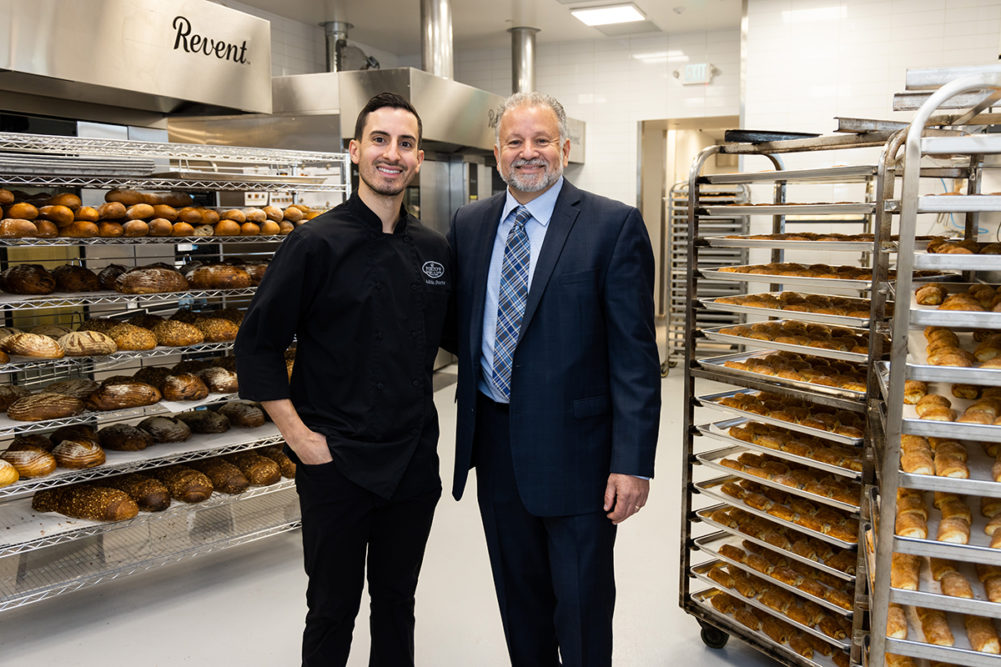Selecting the right oven is one of the most critical decisions a bakery can make. Revent bake specialists Evan Wizner and Michael Landman showcased the dos and don'ts of convection ovens, along with inside secrets to getting longer life and more versatility from your convection oven during the Bread Bakers Guild of America’s February webinar, Getting the Most from Your Convection Oven.
Conventional wisdom says heavy, crusty breads can’t be done in a convection oven. “This is a myth,” the panelists shared.
“To get a crusty finish you need two things: Adequate steam injection. A built-in damper that can be opened and closed. This varies from oven to oven, brand to brand. Not all ovens can yield the results you want.”
By injecting steam in the beginning of the bake with the damper closed, you preserve moisture in the chamber, which prevents premature crust formation and allows for oven spring.
Deck ovens tend to get products to “pop” where convection oven products tend to conform to the pan, or have flatter edges, they explained.
Some convection ovens channel their air in a way that replicates deck ovens, to get that baker’s “pop.”
History of innovation
Convection involves heat transfer via a fluid. In most cases, a fan is pushing your heat through the oven, the panelists explained. Revent invented the rack oven in the 1950s, so bakers didn’t have to push trays into the oven, the Revent bake specialists shared.
Wizner is a test baker for Revent USA who started baking in 2012 in the Bay Area California where he first found a passion for baking sourdough. He spent the past 10 years perfecting his craft while expanding his skillset and knowledge base.
Landman, test baker and food technologist, was born and raised in Peru and has a degree in information systems engineering. Since moving to the US nearly three years ago, he has been training to become better in his craft, starting small baking just a couple sourdough loaves at home per month and then working at Zak The Baker in Miami, Florida, where he found myself baking around 1,500 loaves during the overnight shift for two years. Currently, in addition to baking for Revent, he is also their food technologist, focusing on high- speed cooking ovens in Middlebury, New Jersey
The panelists explain that versatility is a bonus for convection ovens, as the air flow coverage means you can bake anything in a convection oven.
Convection ovens retain less heat than deck or thermal oil ovens, which means it’s easier to move between temperatures for different products.
“For bakeries with high product variety, convection is perfect,” the panelists shared.
Convections ovens are less costly than deck ovens.
You achieve labor savings by being able to easily push in racks, vs. operating a loader/unloader system or doing it all by hand.
Most convection ovens use either a direct fire, a heat exchanger, or electricity to create heat. Heat is transferred to your product by circulating fans and/or by hot air naturally rising.
This process can be compared to deck ovens, which conduct heat directly from a hot stone or clay surface to the product via contact.
Thermal oil ovens use radiation to transfer heat from pipes filled with a special oil to the product in the chamber, without a fan or direct contact.
Some convection ovens have adjustable fan speeds; for best results, use the lowest possible.
Baking oven vs. combi
A combi oven can steam foods and cook in high humidity, to create a juicy steak or veggie platter, for example.
A baking oven uses “steam injection” which fills the chamber briefly with high temperature steam to preserve the moisture of the product while a crust forms.
Combis steam at lower temperatures than baking steam.
Low fan speed allows more air volume in the chamber without drying the product, resulting in an even bake.
Deck ovens are more sensitive to product location within oven, as there is no air flowing through all the products.
Electric or gas?
Bakers achieve the same product results from either.
Electric Ovens have lower maintenance costs as there is no combustion.
Gas ovens usually have lower upfront costs because gas is the cheaper utility in most of the U.S.
Gas ovens need a flue chimney, however, while electric ovens do not.





